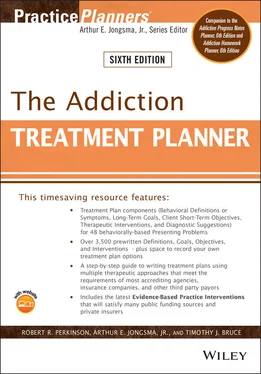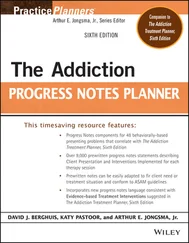The Addiction Treatment Planner
Здесь есть возможность читать онлайн «The Addiction Treatment Planner» — ознакомительный отрывок электронной книги совершенно бесплатно, а после прочтения отрывка купить полную версию. В некоторых случаях можно слушать аудио, скачать через торрент в формате fb2 и присутствует краткое содержание. Жанр: unrecognised, на английском языке. Описание произведения, (предисловие) а так же отзывы посетителей доступны на портале библиотеки ЛибКат.
- Название:The Addiction Treatment Planner
- Автор:
- Жанр:
- Год:неизвестен
- ISBN:нет данных
- Рейтинг книги:4 / 5. Голосов: 1
-
Избранное:Добавить в избранное
- Отзывы:
-
Ваша оценка:
- 80
- 1
- 2
- 3
- 4
- 5
The Addiction Treatment Planner: краткое содержание, описание и аннотация
Предлагаем к чтению аннотацию, описание, краткое содержание или предисловие (зависит от того, что написал сам автор книги «The Addiction Treatment Planner»). Если вы не нашли необходимую информацию о книге — напишите в комментариях, мы постараемся отыскать её.
The Addiction Treatment Planner, Sixth Edition
The Additction Treatment Planner, Sixth Edition
The Addiction Treatment Planner — читать онлайн ознакомительный отрывок
Ниже представлен текст книги, разбитый по страницам. Система сохранения места последней прочитанной страницы, позволяет с удобством читать онлайн бесплатно книгу «The Addiction Treatment Planner», без необходимости каждый раз заново искать на чём Вы остановились. Поставьте закладку, и сможете в любой момент перейти на страницу, на которой закончили чтение.
Интервал:
Закладка:
| ICD-10-CM | DSM-5 Disorder, Condition, or Problem |
|---|---|
| F43.21 | Adjustment disorder, With depressed mood |
| F43.23 | Adjustment disorder, With mixed anxiety and depressed mood |
| F34.1 | Persistent depressive disorder |
| F34.0 | Cyclothymic disorder |
| F63.81 | Intermittent explosive disorder |
| F31.xx | Bipolar I disorder |
| F31.81 | Bipolar II disorder |
| F91.x | Conduct disorder |
| F43.10 | Posttraumatic stress disorder |
| Z69.12 | Encounter for mental health services for perpetrator of spouse or partner violence, physical |
| Z69.82 | Encounter for mental health services for perpetrator of nonspousal adult abuse |
| F60.3 | Borderline personality disorder |
| F60.2 | Antisocial personality disorder |
| F60.0 | Paranoid personality disorder |
| F60.81 | Narcissistic personality disorder |
Note
1  Indicates that the Objective/Intervention is consistent with those found in evidence-based treatments.
Indicates that the Objective/Intervention is consistent with those found in evidence-based treatments.
ANTISOCIAL BEHAVIOR
BEHAVIORAL DEFINITIONS
1 Has a history of breaking the rules or the law (often under the influence of drugs or alcohol) to get his/her/their own way.
2 Exhibits a pervasive pattern of disregard for and violation of the rights of others.
3 Substance use exacerbates antisocial behavior patterns such as criminal activity, aggression and intimidation, thrill seeking, impulsivity, and self-centeredness.
4 Consistently blames other people for his/her/their own problems and behaviors.
5 Uses aggressive behavior to manipulate, intimidate, or control others.
6 Demonstrates a chronic pattern of dishonesty.
7 Lives a hedonistic, self-centered lifestyle, with little regard for the needs and welfare of others.
8 Verbalizes a lack of empathy for the feelings of others, even if they are friends or family.
9 Presents a pattern of criminal activity and addiction, going back to the client's adolescent years.
10 Engages in dangerous, thrill-seeking behavior, without regard for the safety of self or others.
11 Makes decisions impulsively, without giving thought to the consequences for others.
LONG-TERM GOALS
1 Develop a program of recovery that is free from addiction and the negative influences of antisocial behavior.
2 Learn the importance of helping others in recovery.
3 Learn how antisocial behavior and substance use are related and self-defeating.
4 Understand criminal thinking and develop self-talk that respects the welfare and rights of others.
5 Understand the importance of a program of recovery that demands rigorous honesty.
6 Take responsibility for one's own behavior.
| SHORT-TERM OBJECTIVES | THERAPEUTIC INTERVENTIONS |
|---|---|
 Work cooperatively with the therapist toward agreed-upon therapeutic goals while being as open and honest as comfort and trust allow. (1, 2) Work cooperatively with the therapist toward agreed-upon therapeutic goals while being as open and honest as comfort and trust allow. (1, 2) |
Establish rapport with the client toward building a strong therapeutic alliance; convey caring, support, warmth, and empathy; provide nonjudgmental support and develop a level of trust with the client toward his/her/their feeling safe to discuss his/her/their antisocial behavior issues and their impact on his/her/their life.  |
Strengthen powerful relationship factors within the therapy process and foster the therapy alliance through paying special attention to thsese empirically supported factors: work collaboratively with the client in the treatment process; reach agreement on the goals and expectations of therapy; demonstrate consistent empathy toward the client's feelings and struggles; verbalize positive regard toward and affirmation of the client; and collect and deliver client feedback as to the client's perception of his/her/their progress in therapy (see Psychotherapy Relationships That Work: Vol. 1 by Norcross & Lambert and Psychotherapy Relationships That Work: Vol. 2 by Norcross & Wampold).  |
|
| Verbalize an acceptance of powerlessness and unmanageability over antisocial behavior and addiction. (3, 4) | Help the client to understand the self-defeating nature of antisocial behavior and addiction (or assign the Step 1 exercise in The Alcoholism and Drug Abuse Client Workbook by Perkinson). |
| Help the client to see the relationship between antisocial behavior and addiction. | |
| Complete psychological testing or objective questionnaires for assessing antisocial behavior. (5) | Administer to the client psychological instruments designed to objectively assess antisocial behavior, impulsivity, and/or aggression rating instruments (e.g. Psychopathy Checklist-Revised; Aggressive Acts Questionnaire; Barratt Impulsiveness Scale-11); give the client feedback regarding the results of the assessment and test again, if necessary, to assess treatment progress. |
| State how antisocial behavior and addiction are associated with irrational thinking (Alcoholics Anonymous's “insanity”). (6) | Help the client to understand how doing the same things over and over but expecting different results is irrational—what Alcoholics Anonymous calls “insanity.” |
| Provide behavioral, emotional, and attitudinal information toward an assessment of specifiers relevant to a DSM diagnosis, the efficacy of treatment, and the nature of the therapy relationship. (7, 8, 9, 10) | Assess the client's level of insight (syntonic versus dystonic) toward the presenting problems (e.g. demonstrates good insight into the problematic nature of the described behavior, agrees with others' concern, and is motivated to work on change; demonstrates ambivalence regarding the problem described and is reluctant to address the issue as a concern; or demonstrates resistance regarding acknowledgment of the problem described, is not concerned, and has no motivation to change). |
| Assess the client for evidence of research-based correlated disorders (e.g. oppositional defiant behavior with attention-deficit/hyperactivity disorder [ADHD], depression secondary to an anxiety disorder) including vulnerability to suicide, if appropriate (e.g. increased suicide risk when comorbid depression is evident). | |
| Assess for any issues of age, gender, or culture that could help explain the client's currently defined problem behavior and factors that could offer a better understanding of the client's behavior. | |
| Assess for the severity of the level of impairment to the client's functioning to determine appropriate level of care (e.g. the behavior noted creates mild, moderate, severe, or very severe impairment in social, relational, vocational, or occupational endeavors); continuously assess this severity of impairment as well as the efficacy of treatment (e.g. the client no longer demonstrates severe impairment but the presenting problem now is causing mild or moderate impairment). | |
| Consistently follow all rules. (11) | Assign appropriate consequences when the client fails to follow rules or expectations. |
| Identify and verbalize the negative consequences that failure to comply with the rules/limits has had on self and others. (12, 13, 14) | Review with the client several examples where his/her/their rule and/or limit breaking led to negative consequences to self and others. |
| Use role reversal techniques to sensitize the client to his/her/their lack of empathy for others by revisiting the consequences of his/her/their behavior on others (or assign “How I Have Hurt Others” in the Adult Psychotherapy Homework Planner by Jongsma & Bruce). | |
| Teach the client that many negative consequences are preceded by decisions that are based on criminal thinking; ask the client to list five times when antisocial behavior led to negative consequences and list the many decisions that were made along the way. | |
| List the ways dishonesty is self-defeating. (15) | Assist the client in understanding why dishonesty results in more lies, loss of trust from others, and, ultimately, rejection. |
| List the reasons why criminal activity leads to a negative self-image. (16) | Help the client understand why criminal activity leads to feelings of low self-esteem (e.g. loss of respect from others, broken relationships, legal problems, lack of achievement). |
| Verbalize how criminal thinking is used to avoid responsibility and to blame others. (17) | Teach the client how criminal thinking (e.g. super-optimism, little empathy for others, power orientation, sense of entitlement, self-centeredness) avoids personal responsibility and leads to blaming others. |
| Decrease the frequency of statements blaming others or circumstances while increasing the frequency of statements accepting responsibility for one's own behavior, thoughts, and feelings. (18, 19, 20) | Help the client to understand how blaming others results in a failure to learn from one's mistakes and, therefore, making the same mistakes over again (or supplement with “Taking Inventory of Destructive Behaviors” in the Addiction Treatment Homework Planner by Lenz, Finley, & Jongsma). |
| Explore with the client the reasons for blaming others for one's own problems and behaviors, and how he/she/they may have learned this behavior in a punishing family environment. | |
| Confront the client's projection of blame for his/her/their behavior, feelings, and thoughts; reinforce his/her/their acceptance of personal responsibility (or supplement with “Letter of Apology” in the Adult Psychotherapy Homework Planner by Jongsma & Bruce). | |
| Develop a list of prosocial behaviors and practice one of these behaviors each day. (21) | Teach the client the difference between antisocial and prosocial behaviors, then help him/her/them develop a list of prosocial behaviors (e.g. helping others) to practice each day (or supplement with “Benefits of Helping Others” in the Addiction Treatment Homework Planner by Lenz, Finley, & Jongsma or “Three Acts of Kindness” in the Adult Psychotherapy Homework Planner by Jongsma & Bruce). |
| Write a list of typical criminal thoughts; then replace each thought with one that is respectful of self and others. (22, 23) | Confront the client's antisocial beliefs about his/her/their lack of respect for the rights and feelings of others, and model thoughtful attitudes and beliefs about the welfare of others |
| Assist the client in identifying his/her/their typical antisocial thoughts; list an alternate, respectful, and trusting empathic thought. | |
| List five ways Alcoholics Anonymous/Narcotics Anonymous (AA/NA) meetings and a higher power can assist in overcoming antisocial behavior and addiction. (24) | Discuss with the client the various ways recovery groups and a belief in a higher power can assist him/her/them in recovery (e.g. provide emotional support, provide social relationships, relieve anxiety, reinforce self-worth, provide guidance) (or assign the Step 3 exercise in The Alcoholism and Drug Abuse Client Workbook by Perkinson). |
| Receive feedback/redirection from staff/therapist without making negative gestures or remarks. (25) | Confront the client when he/she/they break the rules, blame others, or make excuses. |
| Develop a written plan to address all pending legal problems in a constructive manner. (26) | Assist the client in addressing each legal problem honestly, taking responsibility for his/her/their behavior and relating substance use to legal problems (or supplement with “Accept Responsibility for Illegal Behavior” in the Adult Psychotherapy Homework Planner by Jongsma & Bruce or “What's Addiction Got to Do with My Problems” in the Addiction Treatment Homework Planner by Lenz, Finley, & Jongsma). |
| Encourage at least one person in recovery each day. (27, 28) | Teach the client why it is essential to attend recovery groups and to learn how to help others. |
| Using modeling, role-playing, and behavior rehearsal, practice with the client how he/she/they can encourage others in recovery (or supplement with “Benefits of Helping Others” in the Addiction Treatment Homework Planner by Lenz, Finley, & Jongsma). | |
| Articulate the antisocial and addiction behaviors that have resulted in pain and disappointment to others and, therefore, a loss of their trust. (29, 30, 31) | Assist the client in developing a list of reasons why the trust of others is important as a basis for any relationship. |
| Help the client identify prosocial behaviors that will result in benefits that he/she/they sought from addictive behaviors (or assign “Alternatives to Addictive Behavior” in the Addiction Treatment Homework Planner by Lenz, Finley, & Jongsma). | |
| Confront any denial of responsibility for irresponsible, self-centered, and impulsive behaviors (or supplement with the “Letter of Apology” in the Adult Psychotherapy Homework Planner by Jongsma & Bruce). | |
| Verbalize a desire to keep commitments to others and list ways to prove oneself to be responsible, reliable, loyal, and faithful. (32) | Discuss with the client the importance of keeping commitments and promises to others and ways to prove oneself as trustworthy in relationships. |
| Write an aftercare plan that includes a sponsor, AA meetings, and counseling. (33, 34) | Introduce the client to his/her/their AA/NA sponsor or encourage him/her/them to ask a stable recovery person to be a sponsor; teach him/her/them the many ways a sponsor can be used in recovery. |
| Help the client develop an aftercare program that specifically outlines what AA meetings will be attended, the psychotherapist he/she/they will be working with, and how a daily inventory will be taken (or supplement with “Aftercare Plan Components” in the Adult Psychotherapy Homework Planner by Jongsma & Bruce or “Taking Daily Inventory” in the Addiction Treatment Homework Planner by Lenz, Finley, & Jongsma). | |
| Family members develop an aftercare plan that focuses on what they are expected to do to help the client recover. (35, 36, 37, 38) | Teach the family members about criminal thinking and show them how to help the client correct his/her/their inaccurate thoughts (or supplement with “Crooked Thinking Leads to Crooked Behavior” in the Adult Psychotherapy Homework Planner by Jongsma & Bruce). |
| Teach the family the need to overcome their denial of making excuses for reinforcing or being intimidated by the client's antisocial behavior. | |
| Use behavior rehearsal, modeling, and role-playing to teach the family members conflict resolution skills (or supplement with “Applying Problem Solving to Interpersonal Conflict” in the Adult Psychotherapy Homework Planner by Jongsma & Bruce). | |
| Assist each family member in identifying and listing how to encourage the client to recover from antisocial behavior and addiction. | |
| Develop a five-year written personal recovery plan to address addiction and antisocial traits. (39) | Assist the client in developing a five-year personal recovery plan that outlines how the client will apply concepts learned in treatment going forward. |
| Complete a survey to assess the degree of satisfaction with treatment. (40) | Administer a survey to assess the client's degree of satisfaction with treatment. |
DIAGNOSTIC SUGGESTIONS
Интервал:
Закладка:
Похожие книги на «The Addiction Treatment Planner»
Представляем Вашему вниманию похожие книги на «The Addiction Treatment Planner» списком для выбора. Мы отобрали схожую по названию и смыслу литературу в надежде предоставить читателям больше вариантов отыскать новые, интересные, ещё непрочитанные произведения.
Обсуждение, отзывы о книге «The Addiction Treatment Planner» и просто собственные мнения читателей. Оставьте ваши комментарии, напишите, что Вы думаете о произведении, его смысле или главных героях. Укажите что конкретно понравилось, а что нет, и почему Вы так считаете.












